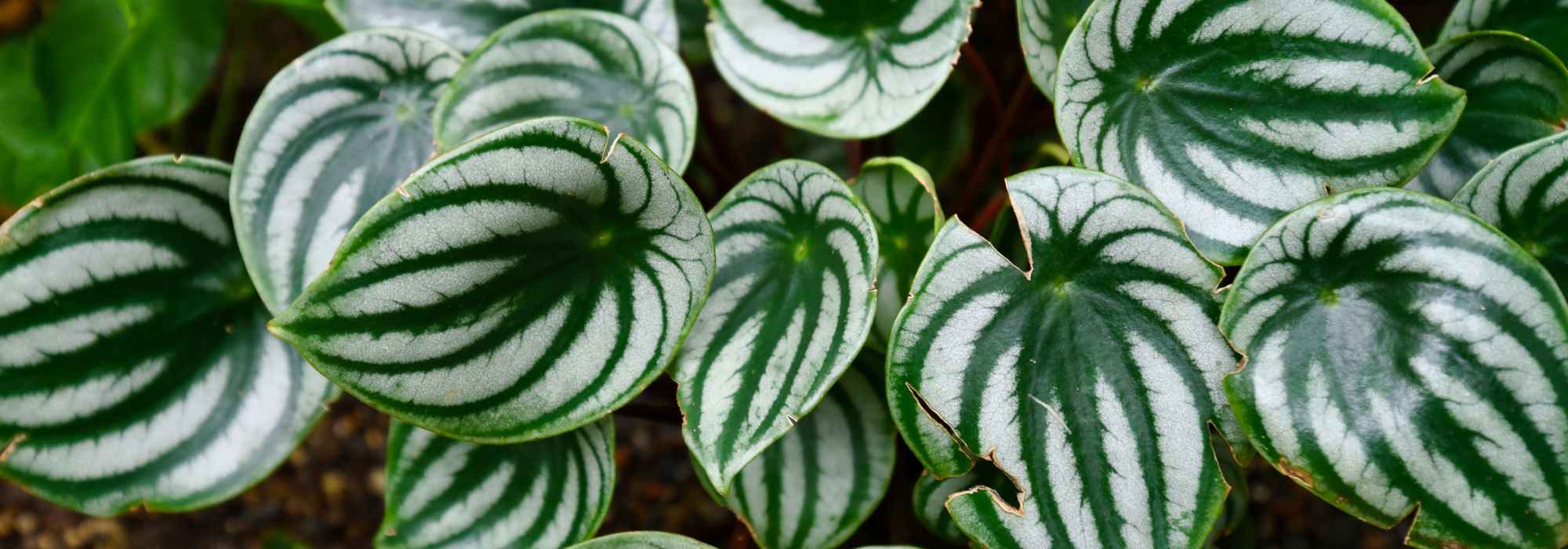
Peperomia : cultivation, care, and choosing the right varieties
Contents
The Peperomia in a nutshell
- Its foliage is decorative, often fleshy and comes in a variety of colours
- With its small size and bushy or trailing habit depending on the variety, it fits in everywhere
- Undemanding, it thrives in well-drained soil with moderate watering, perfect for beginner gardeners
- It never becomes invasive and maintains its elegant appearance all year round
- In pots, terrariums, or hanging baskets, it adds a trendy botanical touch
The word from our expert
The Peperomia is a beloved houseplant prized for the exceptional diversity of its foliage. Native to the tropical regions of South America, this plant adapts easily to our homes and charms with its compact and decorative appearance. It is adored for its varied foliage, ranging from smooth, rounded leaves to crinkled and veined textures. It comes in a multitude of shapes, textures, and colours, from deep green to purple, including silvery or variegated hues. Among the most popular species are Peperomia obtusifolia, Peperomia caperata, and Peperomia rotundifolia, the round-leaf peperomia, each bringing its unique botanical personality.
Easy to grow and low-maintenance, the indoor Peperomia thrives in bright light without direct sunlight and well-draining soil. It requires a slightly humid atmosphere, making it a perfect plant for a bright bathroom. Whether potted on a shelf, hung for trailing varieties, or incorporated into a terrarium, it adapts to all decorative desires.
Let yourself be charmed by its varied forms and unique colours, and give it a place in your home for a natural and elegant ambiance!
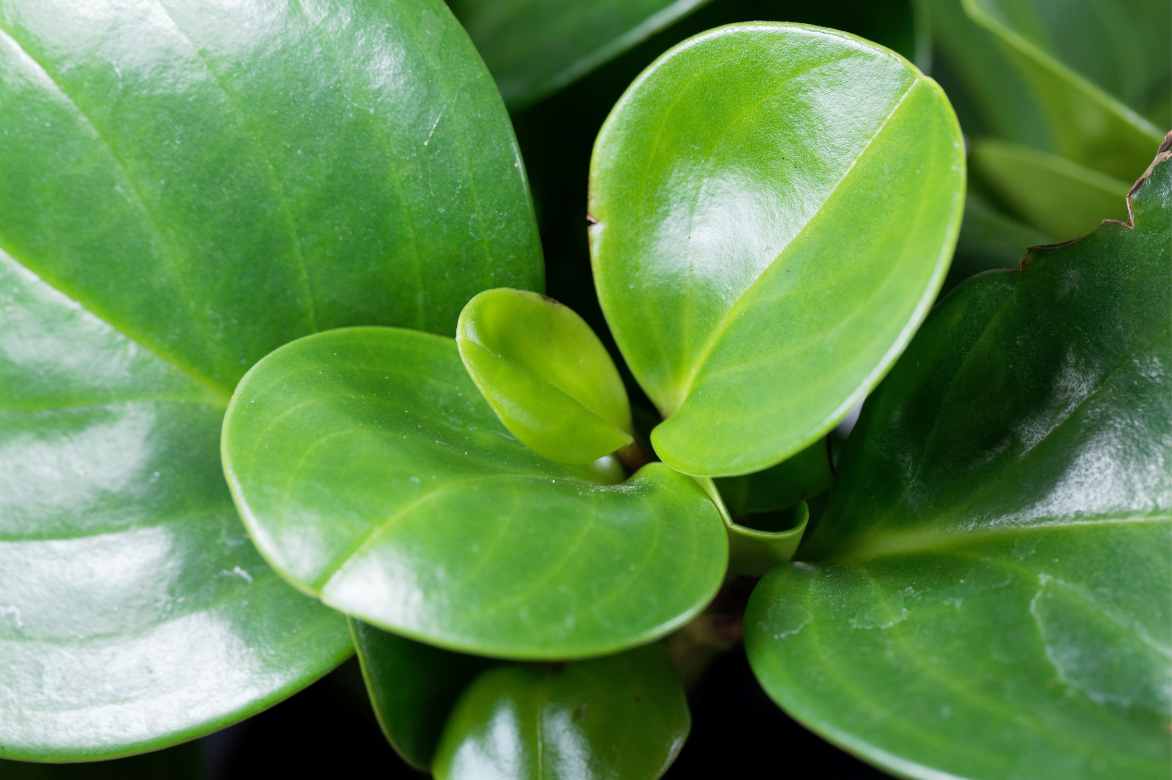
Peperomia obtusifolia
botany
Botanical data
- Latin name Peperomia
- Family Piperaceae
- Common name Peperomia
- Flowering spring-summer
- Height 30 cm
- Exposure Bright
- Soil type Light, well-draining and airy substrate
- Hardiness Frost-sensitive
The Peperomia belongs to the Piperaceae family, the same as pepper. Its genus name, Peperomia, comes from the Greek words peperi (pepper) and homoios (similar), due to its resemblance to the pepper plant. In French, this plant is sometimes called “péperomie” or “rubber plant,” although the latter name is also attributed to other species.
Native to tropical and subtropical regions of Central and South America, as well as Southeast Asia, Peperomia grows naturally under the canopy of humid forests. It thrives in shady and moist environments, often nestled on the forest floor or as an epiphyte on trees, benefiting from filtered light and ambient humidity. Peperomia can be considered a succulent plant, but only partially. Its thick, fleshy leaves allow it to store water, making it more drought-resistant than other tropical plants. However, unlike classic succulents like cacti or euphorbias, it cannot tolerate prolonged drought and prefers a slightly humid atmosphere.

Botanical plates: Peperomia obtusifolia (circa 1960) and Peperomia resediflora
The Peperomia genus includes over 1,500 species. Among the most commonly cultivated are:
- Peperomia rotundifolia or round-leaf Peperomia: known for its trailing habit and small, round, bright green leaves, ideal for hanging baskets or cascading arrangements.
- Peperomia obtusifolia: prized for its round, thick, and glossy leaves, in deep green or variegated hues.
- Peperomia argyreia: nicknamed “watermelon,” it charms with its round foliage striped in green and silver, offering a unique and graphic appearance.
- Peperomia polybotrya: features large, round, and shiny leaves shaped like water droplets.
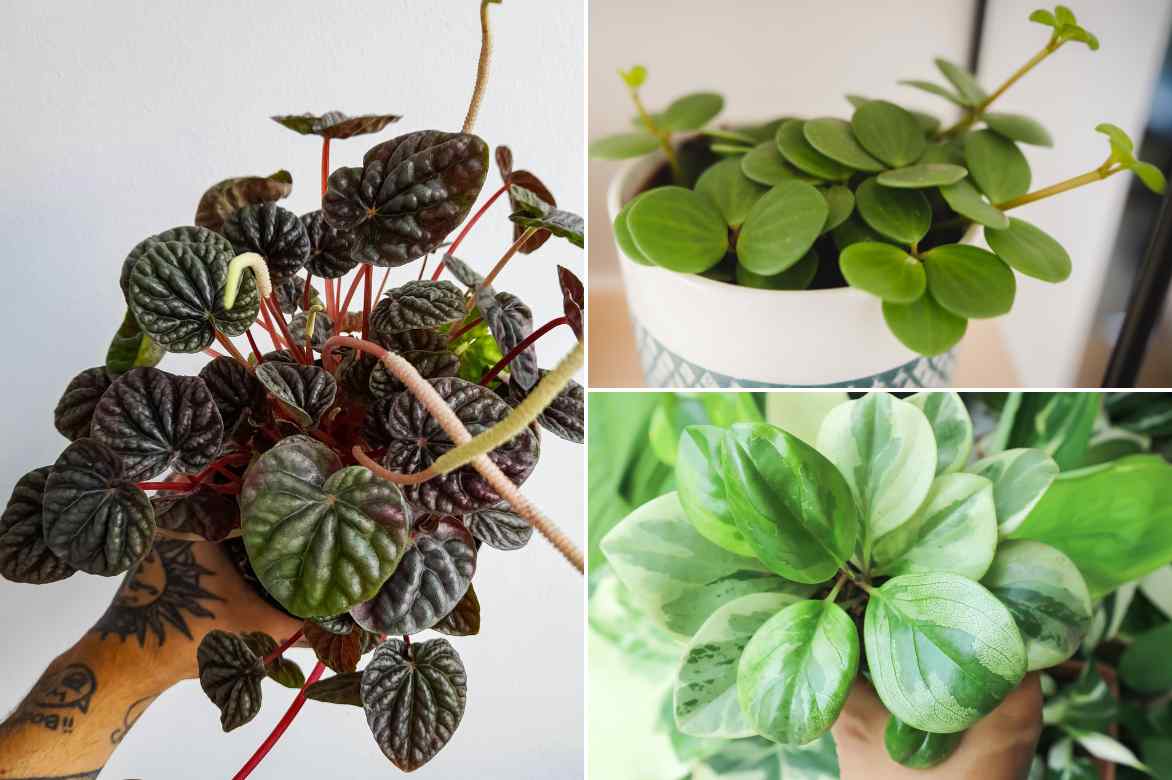
Peperomia caperata, Peperomia tetraphylla ‘Hope’ and Peperomia obtusifolia
These species have given rise to numerous cultivars, selected for their foliage with varied colours and textures. Among the most popular are Peperomia obtusifolia ‘Variegata’, a variegated version in green and cream, very bright. Peperomia caperata ‘Rosso’ stands out with its crinkled dark green leaves on top and bright red underneath. Peperomia ‘Raindrop’ has thick, fleshy leaves shaped like water droplets. Peperomia ‘Hope’ is recognisable by its thick, glossy foliage and compact habit. Finally, Peperomia caperata ‘Luna Red’ distinguishes itself with its entirely purple, crinkled leaves.
Peperomia is a small, herbaceous plant, generally compact, with a bushy, creeping, or upright habit depending on the species. Its root system is underdeveloped, often consisting of fine, fibrous roots, allowing it to adapt to pot cultivation and even epiphytic life in its natural habitat. It rarely exceeds 30 cm in height, although some creeping species can spread more widely.
Its stems, sometimes thick and fleshy, can be brittle and retain a semi-succulent texture that aids water storage. The foliage, a distinctive feature of the genus, displays a great diversity of shapes and textures, ranging from round and glossy leaves to crinkled, lanceolate, or heart-shaped ones. Depending on the species, their surface can be smooth, plicate, velvety, or even marbled with silvery, purple, or dark green patterns.
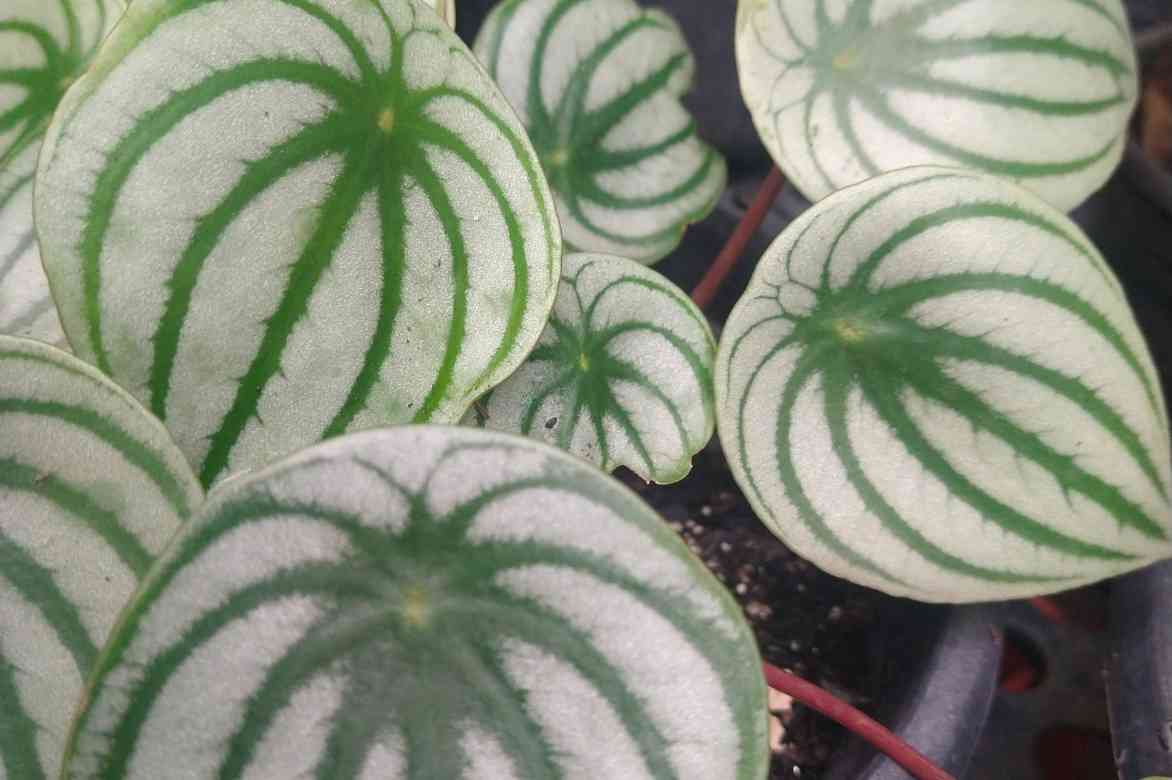
Peperomia argyreia
The flowering of Peperomia is discreet and not particularly ornamental, consisting of slender, upright spikes, often whitish or greenish, similar to those of other members of the Piperaceae family. It appears in spring or summer. These tiny flowers, lacking showy petals, emit little or no fragrance and play only a secondary role in the plant’s appeal. Since flowering requires energy, some varieties rarely bloom when grown indoors. Fruiting, though possible, is rarely observed in indoor cultivation and manifests as tiny spherical berries containing fine seeds.
Main species and varieties
- Peperomia caperata Luna
- Peperomia caperata Quito®
- Peperomia Colombiana
- Peperomia caperata Montevideo
- Peperomia caperata Rosso
- Peperomia clusiifolia Red Margin
- Peperomia Piccolo Banda
- Peperomia Fire Sparks®
- Peperomia Hope®
- Peperomia obtusifolia Bicolor
- Peperomia Nevada
- Peperomia obtusifolia USA
- Peperomia obtusifolia Green
- Peperomia Red Canyon
- Peperomia prostrata
- Peperomia rotundifolia
Growing Peperomia Indoors
Where to Place the Peperomia in the House?
Native to tropical and subtropical regions, the Peperomia is particularly sensitive to cold and cannot tolerate temperatures below 10-12°C. Exposed to overly cool conditions, it quickly shows signs of stress, such as slowed growth, wilting foliage, or an increased risk of root rot.
It cannot withstand frost or sudden temperature fluctuations, which is why it is exclusively grown indoors in temperate climates. It thrives in a stable environment between 18 and 24°C, which corresponds to typical indoor temperatures. It is therefore essential to keep it away from open windows in winter, frequently used doors, or direct heat sources like radiators, which dry out the surrounding air.
It also requires high humidity levels. Generally, Peperomias grow best when humidity levels are between 40% and 60%. To maintain this humidity level, you can place the pot on a tray filled with damp gravel or clay pebbles, or group several plants together to create a more humid microclimate. In any case, avoid placing it near radiators or heating vents that dry out the air. Using a humidifier can also be beneficial if your environment is particularly dry.
The Peperomia is a houseplant that thrives under bright, indirect light. Placed near an east or west-facing window, it benefits from good natural lighting without being exposed to the scorching rays of the sun, which could dry out or burn its delicate foliage. Filtered light, such as that diffused by a sheer curtain or from a well-lit room, can also work, although its growth may be slower and its foliage potentially less vibrant.
Too much shade can weaken the plant, making it more fragile and reducing the brilliance of its patterns and hues, especially in variegated varieties, which require more light to maintain their contrasts.
When to Plant a Peperomia in a Pot?
Potting can be done year-round, with a preference for spring or summer, when the plant is in full growth.
How to Plant Peperomia in a Pot?
Substrate
The Peperomia needs a light, well-draining, and aerated substrate to avoid excess moisture, which could lead to root rot. The substrate’s pH should be slightly acidic to neutral, around 6 to 7. An ideal mix includes:
- A good houseplant potting mix (50%)
- Turf (30%) for moisture retention
- Perlite or coarse sand (20%) to improve drainage
Choosing the Pot
Since the Peperomia has a small root system, it does not need a large pot. It is best to choose a container proportionate to the size of the plant, slightly larger than the root ball and with drainage holes at the bottom, to avoid stagnant moisture. A terracotta pot is ideal, as it allows better water evaporation and reduces the risk of overwatering. However, a plastic pot with drainage holes also works well, provided you monitor watering. The Peperomia also thrives in semi-open or open terrariums.
Potting
- Place a layer of clay pebbles, gravel, or small stones at the bottom of the pot to improve water drainage.
- Add a mix of potting soil, turf, and perlite, leaving enough space for the root ball.
- Gently remove the Peperomia from its original pot, lightly shake the roots to remove excess soil, and place it in the center of the new pot.
- Fill in around the roots with substrate, lightly pressing with your fingers to ensure stability without compacting the soil too much.
- Water lightly to moisten the substrate without soaking it, then let the plant acclimate to its new environment.
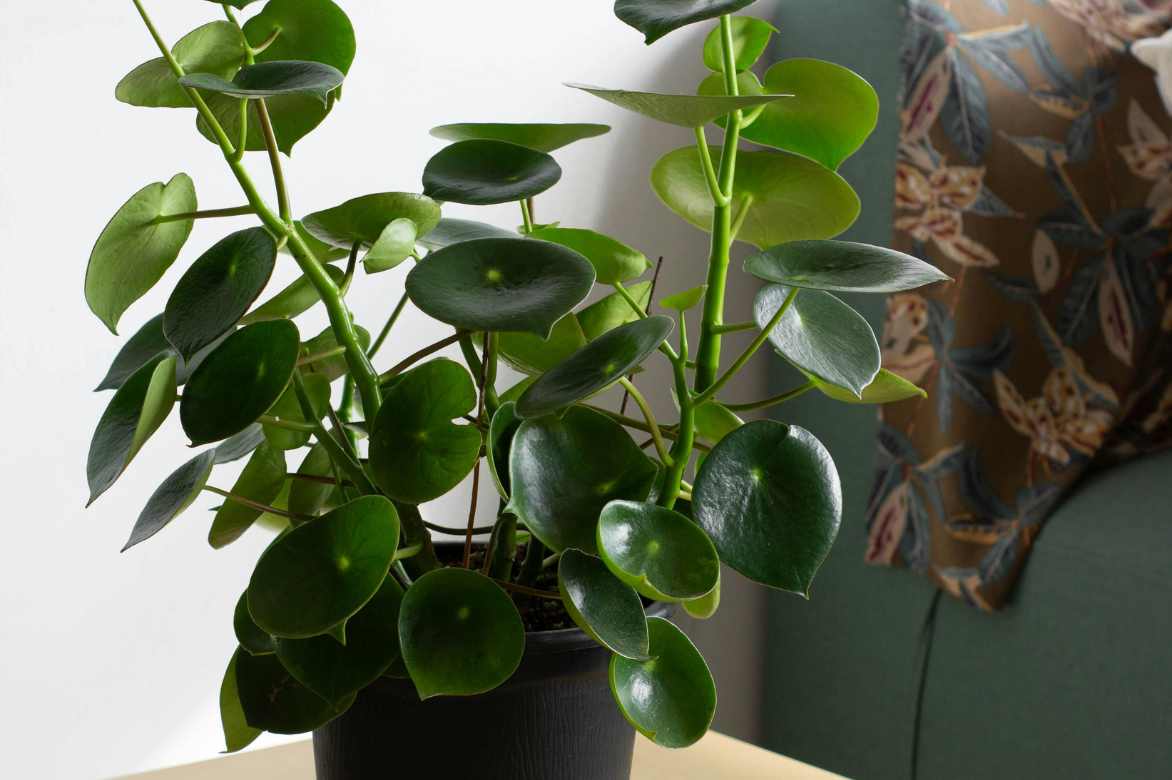
Peperomia polybotrya
Planting in a Terrarium
Opt for a terrarium with a lid to maintain high humidity. A glass terrarium is ideal, as it allows light to pass through while retaining moisture.
- Use a well-draining potting mix.
- Place the terrarium in a bright spot but out of direct sunlight.
- Maintain high humidity by misting the inside of the terrarium regularly or using a tray of water with pebbles to increase ambient humidity.
- Open the terrarium occasionally to allow air circulation and prevent mold growth.
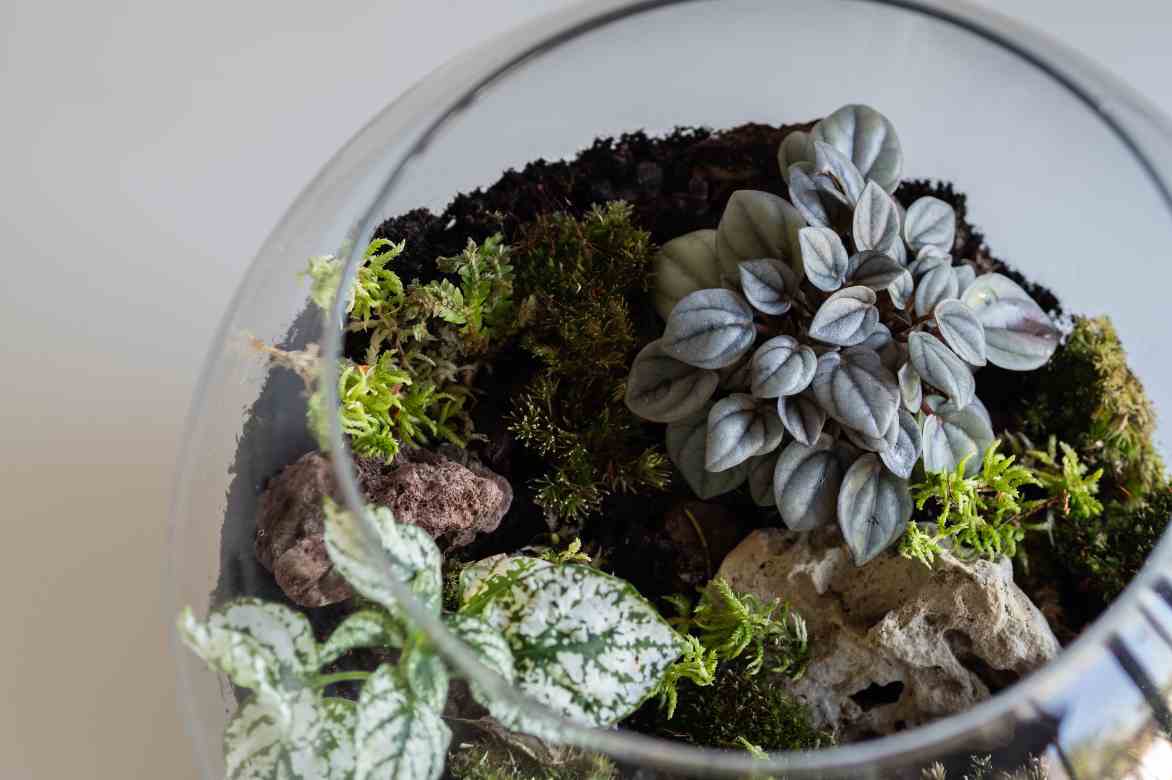
Peperomia caperata, Fittonia, and moss in an open terrarium
Maintenance of the Peperomia
Watering
The Peperomia requires moderate watering, as its fleshy leaves allow it to store some water. During the growth period (spring-summer), water approximately once a week when the substrate is dry on the top few centimetres. Ensure you let the surface dry out between waterings. In autumn and winter, watering should be reduced to once every 2 to 3 weeks to avoid excess moisture, which could lead to root rot. It is recommended to use water at room temperature, preferably non-calcareous.
Misting
Misting is not recommended for the Peperomia, as its thick leaves retain moisture. When water stagnates on the foliage, it can encourage the development of fungal or bacterial diseases. If the air is too dry, it is better to opt for a tray with clay pebbles and water or simply place a container of water nearby to mimic the humid conditions of its native tropical habitat.
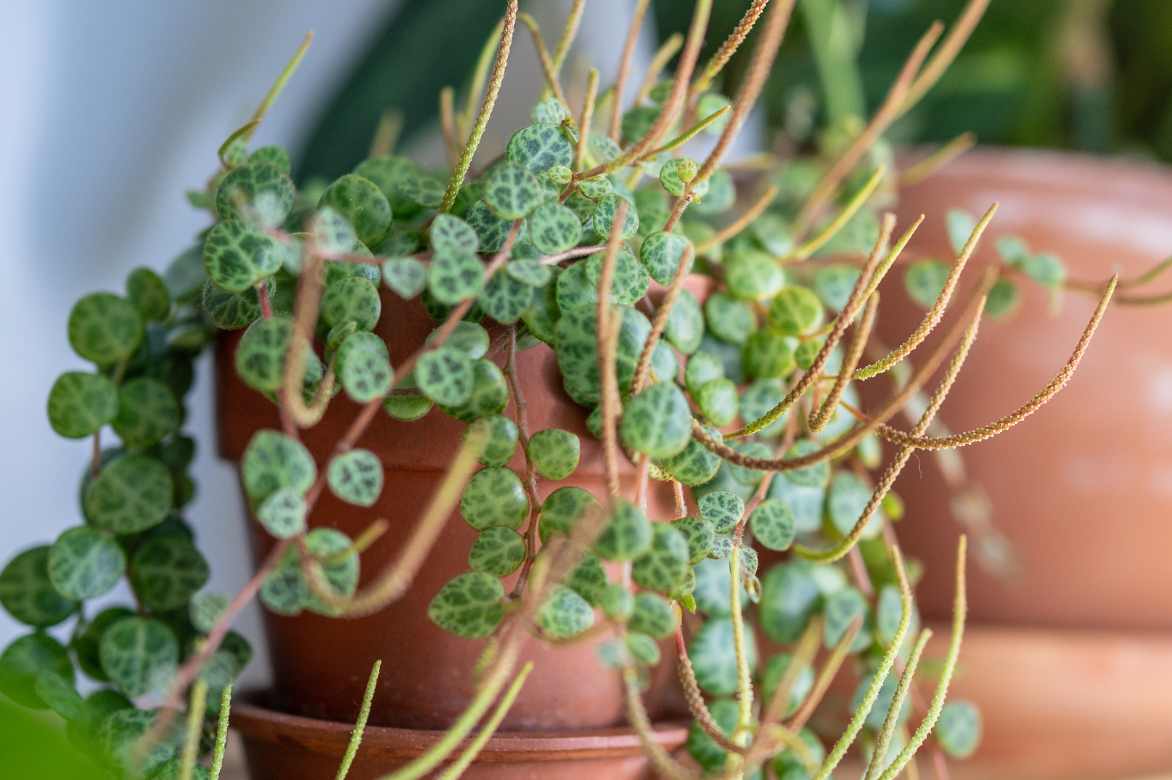
Peperomia prostrata
Fertilisation
Fertiliser is advised during the growth period, from spring to late summer. A balanced liquid fertiliser diluted to half the recommended dose can be applied every four weeks. In winter, fertilisation is unnecessary, as the plant enters a dormant phase.
Pruning
The Peperomia does not require specific pruning, but you can pinch the tips of the stems (cut the top part of the stem, usually just above a node with your fingers) to stimulate branching and achieve a more compact habit. It is also advisable to regularly remove yellowed or damaged leaves to promote healthy growth and prevent diseases.
Repotting the Peperomia
As the Peperomia has a relatively small root system, it does not require frequent repotting. Repotting every 2 to 3 years is sufficient, mainly when the roots start to completely fill the pot or the substrate becomes depleted. The best time to repot is in spring, when the plant resumes active growth. Choose a slightly larger pot with drainage holes and refresh the substrate to ensure a good supply of nutrients. When repotting, it is important to handle the plant gently to avoid damaging its fragile roots. Once placed in its new pot with fresh, well-draining substrate, a light watering helps encourage recovery without saturating the soil.
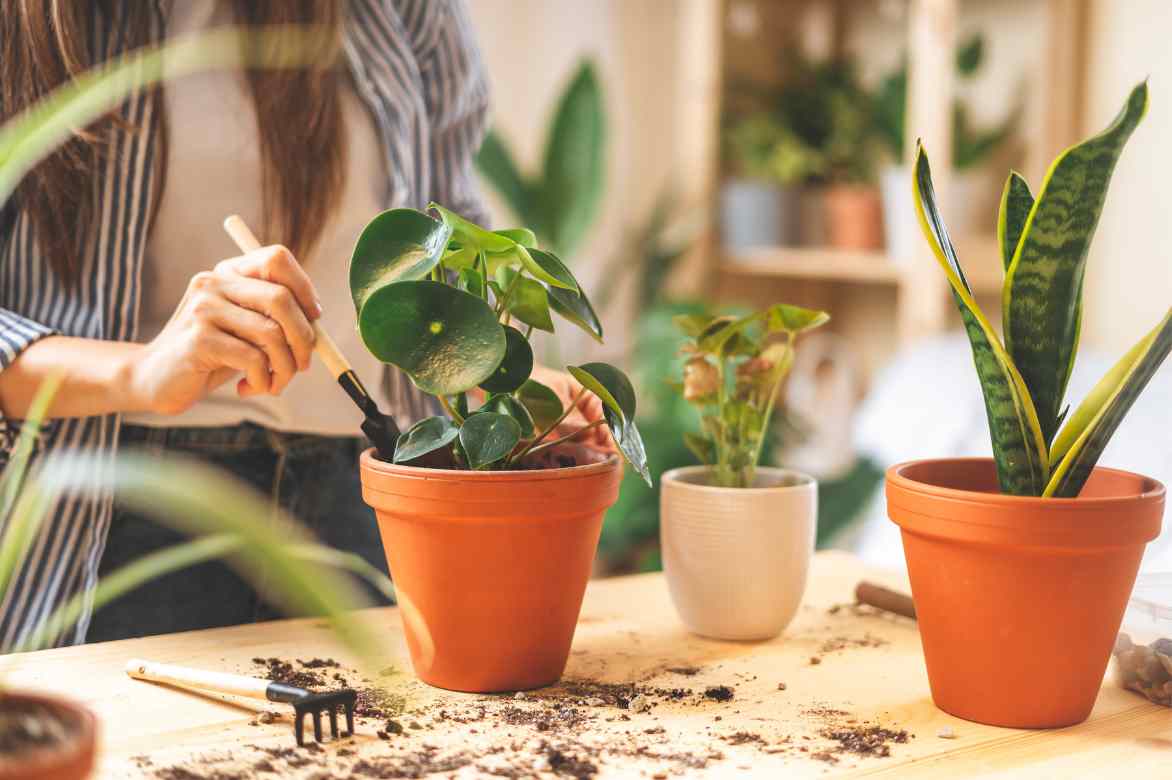
Common Diseases and Parasitic Pests of Peperomia
The Peperomia is a relatively hardy plant, but it can be susceptible to certain diseases and parasitic attacks, especially if cultivation errors occur.
Common Diseases
- Root rot: caused by overwatering or poor drainage. The roots turn black and soft, and the foliage yellows and falls off. Reduce watering and repot in a dry, well-draining substrate.
- Botrytis (grey mould): encouraged by excessive humidity and poor ventilation. It appears as a greyish coating on the leaves. Remove affected parts and improve air circulation.
- Leaf spots: caused by fungi or bacteria, often due to excessive moisture on the foliage. Avoid overhead watering and treat with an organic fungicidal spray if necessary.
Common Parasites
- Mealybugs: small cottony clusters on stems and under leaves, weakening the plant. They can be removed with a cotton swab dipped in 70° alcohol or a spray of diluted black soap.
- Aphids: small green or black insects that suck the sap. A lukewarm water shower or a black soap treatment can eliminate them.
- Spider mites: appear in dry conditions and cause yellowing of leaves with fine webs under the foliage. Increasing ambient humidity and a nettle-based treatment or black soap helps eradicate them.
Propagation of Peperomia by cuttings
The Peperomia can be easily propagated by stem or leaf cuttings, either in water or directly in soil.
1. Propagation in Water
This method is simple and allows you to monitor the development of roots before replanting the cutting in soil.
Steps for propagation in water:
- Choose a healthy stem: take a vigorous stem of 5 to 10 cm, with at least one or two nodes (areas where leaves and roots emerge).
- Remove the lower leaves: leave only 2 or 3 leaves at the top to reduce evaporation and encourage rooting.
- Place in a glass of water: immerse the base of the stem in a container of room-temperature water, ensuring no leaves touch the water.
- Change the water regularly: replace the water every 3 to 4 days to prevent the growth of bacteria and support healthy rooting.
- Wait for roots to appear: within 2 to 4 weeks, roots will develop. Once they reach 2 to 3 cm, the cutting can be transplanted into a pot with a light, well-draining substrate.
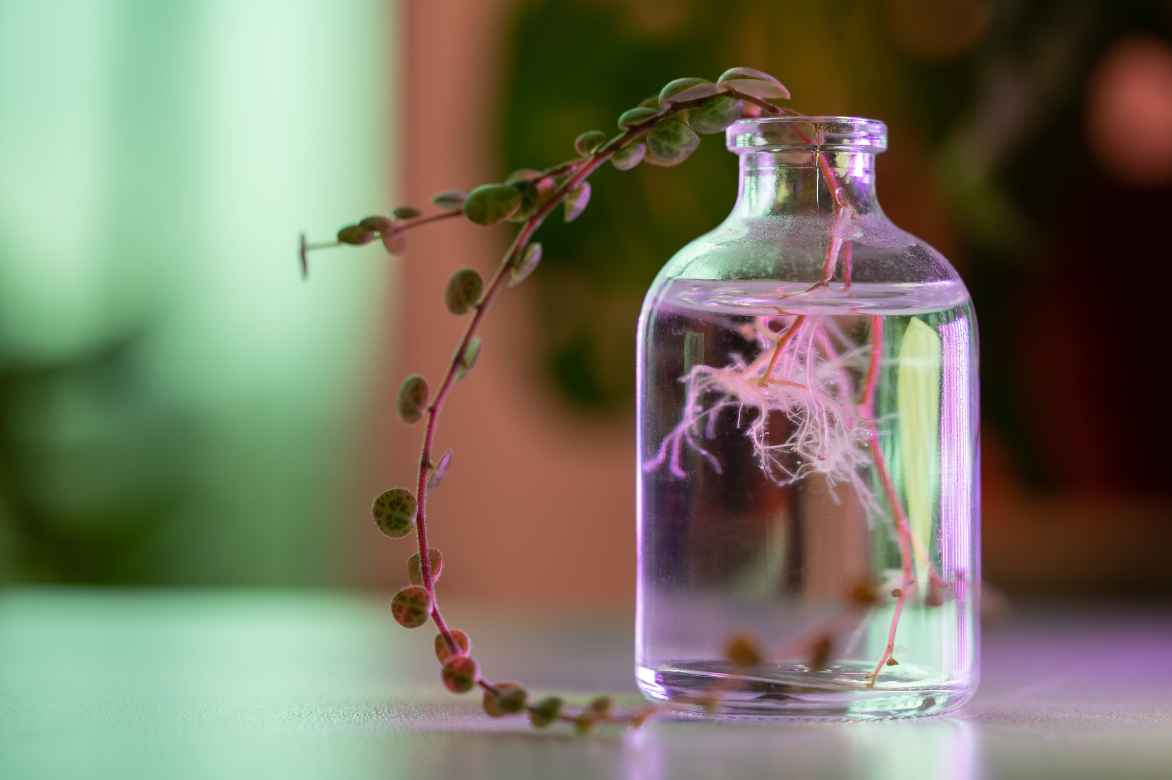
Peperomia prostrata
2. Propagation Directly in Soil
This method allows the cutting to adapt directly to the substrate without the water stage.
Steps for propagation in soil:
- Prepare the substrate: use a mix of potting soil for houseplants and perlite or coarse sand to ensure good drainage.
- Take a stem or leaf cutting: cut a stem with at least one node or a leaf with its petiole (the small stem that attaches it).
- Plant the cutting: gently insert the base of the stem or the leaf petiole into the substrate, burying it slightly.
- Moisten the substrate: water lightly to maintain consistent moisture without saturating the substrate.
- Create a humid atmosphere: place a transparent plastic bag over the pot to retain moisture and speed up rooting.
- Monitor growth: within 3 to 6 weeks, new roots will develop, and the cutting can be cared for like a mature plant.
How to showcase the Peperomia in your home?
Easy to grow, aesthetically pleasing, and adaptable to all styles, the Peperomia adds a trendy and fuss-free botanical touch to our interiors. It pairs beautifully with raw terracotta pots, macramé hangers, or rattan planters for a warm and natural vibe. Varieties with crinkled or variegated leaves, such as Peperomia caperata or Peperomia argyreia, are particularly suited to this play of textures.
For a more contemporary interior, opt for ceramic pots in neutral or pastel shades, emphasising elegance and simplicity. Paired with other houseplants like a Pilea or a Ficus, the Peperomia creates a lovely, easy-to-maintain botanical contrast.
It’s perfect for open terrariums, where its small, fleshy leaves add depth and freshness. Low-maintenance, it’s also an ideal choice for brightening up a well-lit bathroom, where its love for humidity will be perfectly matched.
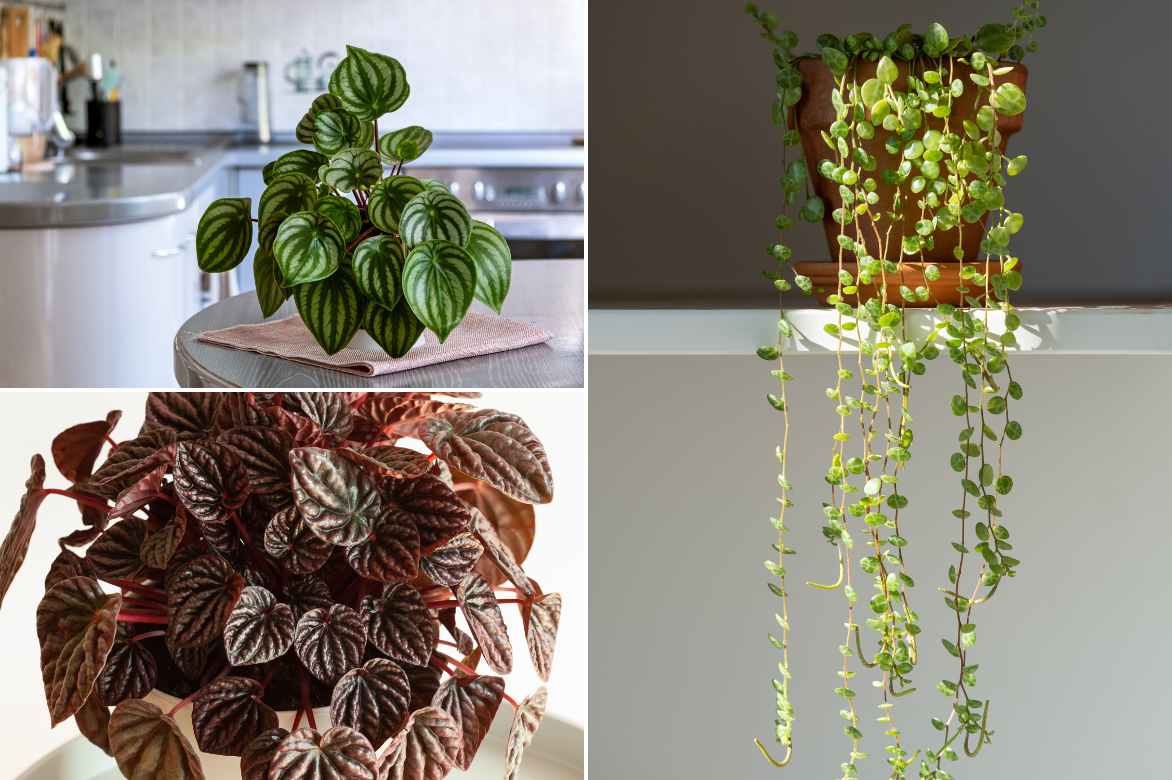
In a pot in the kitchen (Peperomia argyreia), elevated for trailing species like the prostrata, the Peperomia fits in everywhere!
Useful resources
→ Discover our wide range of houseplants.
→ Many books on houseplants exist, but we recommend: The Encyclopaedia of Houseplants by Solène Moutardier, published by Ulmer.
- Subscribe!
- Contents
































Comments